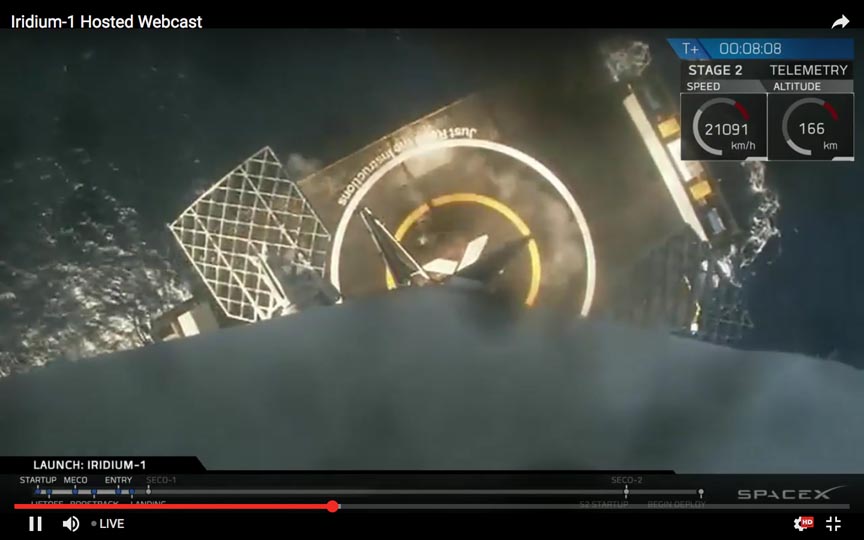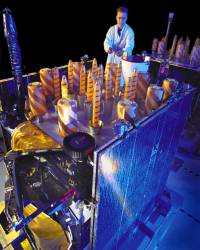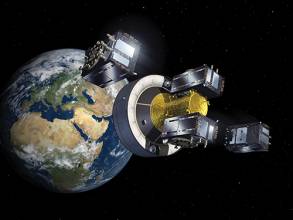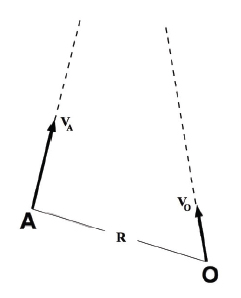A January 14 launch of 10 Iridium NEXT satellites will help implement a space-based automatic dependent surveillance–broadcast (ADS-B) developed by Aireon, in partnership with leading Air Navigation Service Providers (ANSPs) from around the world, and designed to provide real-time GNSS tracking of aircraft over oceanic regions.
A January 14 launch of 10 Iridium NEXT satellites will help implement a space-based automatic dependent surveillance–broadcast (ADS-B) developed by Aireon, in partnership with leading Air Navigation Service Providers (ANSPs) from around the world, and designed to provide real-time GNSS tracking of aircraft over oceanic regions.
The Iridium NEXT satellites were successfully launched from Vandenberg Air Force Base in California into low Earth orbit (LEO) by Space Exploration Technologies Corporation (SpaceX). These are the first of what will be a 66-LEO satellite constellation that will extend ADS-B across the planet.
SpaceX’s Falcon 9 rocket is delivering 10 satellites to LEO for Iridium, a global mobile voice and data satellite communications company with headquarters in McLean, Virginia. The 10 satellites are the first of at least 70 satellites that SpaceX will be launching for Iridium’s next generation global satellite constellation, Iridium NEXT.
SpaceX succeeded in bringing its first stage back to a landing on an unmanned autonomous spaceport drone ship (ASDS, named "Just Read the Instructions") off the California coast. This maneuver required use of GPS, inertial, and other positioning/navigation technologies.
The controlled descent and landing operation requires the rocket’s first stage, after separating from the upper stages of the Falcon 9, to perform a flip maneuver, reenter from space at hypersonic velocity, restart main engines twice, deploy land¬ing legs, and touch down at near zero velocity. This requires a carefully orchestrated naviga¬tion of the rocket and positioning of the drone ship.
SpaceX has estimated that being able to reuse the first stage of a Falcon 9 would reduce cost about 30 percent for a subsequent flight, which would bring the rocket’s price tag down substantially.
According to the McLean, Virginia¬–based Aireon, Iridium has partnered with SpaceX for a series of seven launches over the course of 18 months out of Vandenberg Air Force Base. All 81 Iridium NEXT satellites are equipped with the Aireon payload. Once in orbit, each satellite will undergo extensive testing by the Iridium team and, after approximately 40–60 days, Iridium will hand-off the ADS-B payloads to Aireon for verification of on-orbit technical specifications.
“Today is a landmark moment in history for global air traffic surveillance, air traffic safety and the aviation industry as a whole,” Don Thoma, CEO, Aireon, said on the company’s website. “This successful first launch brings us one step closer to changing the way the world flies by enabling the ability to track aircraft anywhere on the planet. Once our global ADS-B surveillance service is fully deployed, every ADS-B equipped aircraft can have its precise location accounted for 24/7.”
According to Aireon, Iridium will conduct rigorous independent testing and validation of the space-based ADS-B system for approximately 60 days. As part of this testing and validation process, Aireon’s ADS-B receivers, which were manufactured by Harris Corporation, will provide air traffic surveillance data through the Aireon network to the Service Delivery Points (SDPs) at partners NAV CANADA, NATS, ENAV, the Irish Aviation Authority (IAA), as well as the Federal Aviation Administration (FAA) William J. Hughes Technical Center in Atlantic City, New Jersey.
This latest launch is a collaborative effort and is expected to bring about key advances to air traffic surveillance.
“This launch signifies the beginning of a new era in air traffic surveillance that would not have been possible without the incredible work of our talented team and the support of all of our partner organizations,” said Eamonn Brennan, chief executive of the Irish Aviation Authority, as reported on the Aireon website. “This is a transformational technology that will equip Aireon customers with the most advanced air traffic surveillance capabilities available.”






